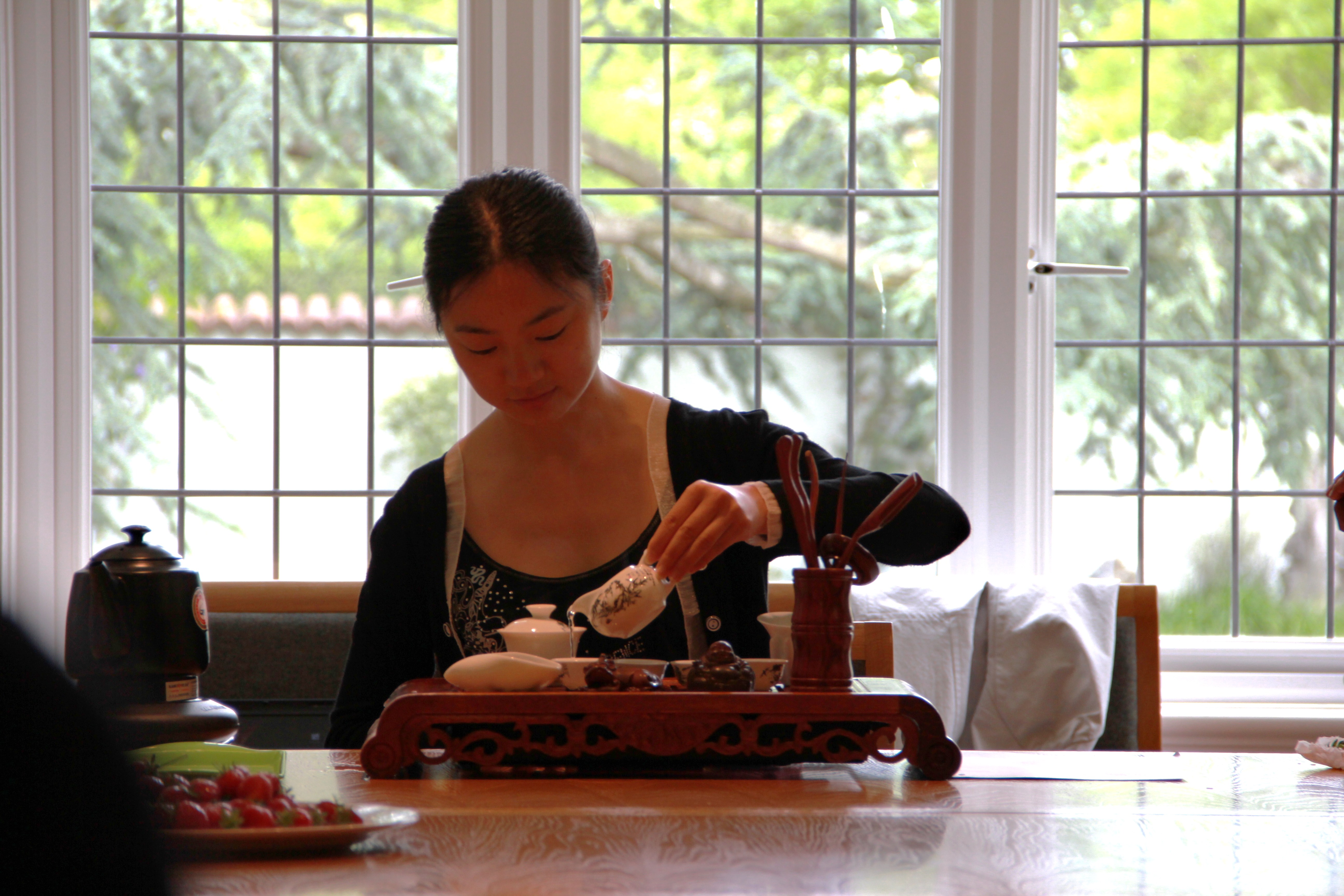<html>
<div style="font-family: Chalkduster; font-size: 13pt; color: #fff;">
<ul>
<li> <a href="http://www.camcc.org/">Home</a> + <a href="http://www.camcc.org/events">Events</a>
</li><li> <a href="http://www.camcc.org/about/Chinese-classics">Chinese Classics</a>
</li><li> Reading Groups
<ul>
<li> <a href="http://www.camcc.org/reading-group"> Chinese </a>
</li><li> <a href="http://www.camcc.org/reading-group/en/">English<sup>beta</sup></a>
</li></ul>
</li><li> <a href="http://www.camcc.org/discussion-group/">Discussion Grp.</a>
</li><li> <a href="http://www.camcc.org/tea-party">Tea Ceremony</a>
</li><li> <a href="http://www.camcc.org/tea-yoga">Tea Yoga</a>
<!--
</li><li> <a href="http://www.camcc.org/other-activities">More Activities</a>
-->
</li><li> <a href="http://www.camcc.org/blog/">Blog</a> + <a href="http://www.camcc.org/links">Links</a>
</li><li> <a href="http://www.camcc.org/about/">About Us</a>
<!--</li><li> <a href="http://www.camcc.org/contact">Contact Us</a> -->
</li><li> <a href="http://www.camcc.org/internal/home">Internal</a>
</li></ul>
</div>
</html>
----
[[president@camcc.org|Email us]]. Or follow us
on [[http://www.facebook.com/groups/182337131809002/|{{facebook.png?32}}]] [[http://page.renren.com/601199149|{{renren_logo.jpg?32}}]] [[http://blog.sina.com.cn/u/1965219823|{{wordpress.png?32}}]]
<html>
<div style="margin-top:-19px">
<div style="width: 22%; float: left; text-align:center">
<a href="http://www.camcc.org">
<img src="http://www.camcc.org/_media/logo-经典方篆-roften.png" width="145" height="145" alt="Camcc" />
</a>
</div>
<div style="width:78%; height:145px; float:right; margin-top: 0px; border-bottom:solid 5px #000000;">
<div style="width: 3%; float: left; margin-top:40px;"></div>
<div style="width: 67%; float: left; font-size: 115%; margin-top:15px;">
<h1>
Cambridge Chinese Classics</br>
剑桥中国传统文化研习社
</h1>
To study, practice and promote Chinese classics
</div>
<div style="width: 30%; font-size: 80%; margin-top: -10px; float: left;">
<div style="height: 130px;width: 100%;float:left">
</html>
**Coming events:**
{{iCalendar>https://www.google.com/calendar/ical/cam.chineseclassics%40gmail.com/public/basic.ics#from=today&previewDays=30&showEndDates=1&&numberOfEntries=1&showAs=list}}
<html>
</div>
<div style="height: 20px;width: 100%;float:left">
Join our <a href="https://lists.cam.ac.uk/mailman/listinfo/soc-camcc">mailing list</a>
</div>
</div>
</div>
</div>
<style>
#dokuwiki__aside {
//border-right: dashed 1px black;
border-right: none;
}
.dokuwiki .wrapper {
border-bottom: solid 1px black;
}
blockquote {
border-left: none !important;\\2px solid #8cacbb;
padding-left: 0.6em !important;
}
div.dokuwiki div.comment_wrapper { background-color: transparent !important;}
</style>
</html>
Sidebar
Table of Contents
Tea and Zen
by Yiru Wang
Date: June, 9th, 2012
Topic: 禅茶一味 Tea and Zen
Performer: Yiru Wang
Host: Qiaosheng Dong
Location: Plommer House A, Wolfson College, Cambridge, UK
Introduction
禅与茶本是两种文化,在其各自的发展历史中相互渗入,相互影响,融合而成为一种新的文化形式——禅茶一味的禅茶文化。作为中国文化的一部分的禅茶文化是中国传统文化之精神在人生日用中的落实与升华。是中国传统文化史上的独特现象,是中国对世界文明的独特贡献。
In Chinese history, ‘to have tea’ is a famous story in Zen Buddhism. It also become a common way of practicing Buddhism in Zen monasteries, become a popular and graceful practice among scholars. There are numerous people got enlightened during having their tea, there are numerous poems, verses, and allegories of having tea. But nowadays, not many people still understand.
禅是心悟,茶是物质的灵芽,一味是心与茶,心与心的相通。
Zen is perception of heart, tea is spiritual the bud of material. One taste means the connection between the heart and the tea, between heart and heart.
禅的精神在于悟,茶之意境在于雅。茶承禅意,禅存茶中。把茶的内在精神体验用言语和艺术表现出来就是雅,而“雅”所蕴含的无限内涵是需要“吃茶去”才能体验的。
Engaging in a ceremony means we give ourselves over to the wonder of making an art with our bodies, minds and hearts.
现在,就请大家放下世俗烦恼、抛弃功利之心,以平和虚静之心,来领略禅茶一味的真谛。
Now, let’s embark on this living path of chadao – the way of tea, with a calm and tranquil heart.
Procedures of Kungfu Tea
- 神入茶境 Prepare the tea sets and add appropriate amount of tea leaves into the tea dish. Calm down and let the heart Penetrate into the tranquility of tea.
- 烹煮甘泉 Boil the water
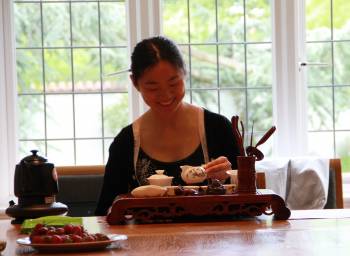
禅茶一味: enjoy myself and forget myself - There is no separation between the tea and Yiru!:)
泡茶之水是十分关键的。八分之茶浴十分之水,茶便十分矣。十分之茶浴八分之水,茶只八分而。中国古人泡茶,讲究“活水需用活火烹”:需用鲜活清澈的泉水方能泡出真味的好茶。从燃烧的火光中,我们感悟人生的短促及生命的辉煌。
一粒粟中藏世界,半中煮山川。法海听音,随机相应。
The water of making tea is very important. We can make good tea only with good water. In ancient times, Chinese people used ‘living fire’ to boil the ‘living water’ for making tea —-the water are usually from the fresh and alive spring water. Today, we boil this spring water. Also, people percept the shortness and splendor of the life from the burning fire.
A grain of sand contains of the whole world. In this small tea pot, we boil the mountains and rivers. Listening to the sound, our hearts resonate with every moment passing by.
- 沐淋瓯杯/白鹤沐浴 Clean and warm the tea sets with hot water, including the cups, Gaiwan and tea filter, also called white cranes bathing in water.
- 观音入宫 Cast tea from the tea holder or tea dish in to the Gaiwan using the teaspoon.
- 悬壶高冲 (又称凤凰三点头) Pour the hot water into the Gaiwan from a high position, also called Phoenix Nodding Head 3 Times (lift the kettle high and pour it down in 3 distinct movements).
- 春风拂面 Remove the bubbles on the surface of the tea with the Gaiwan lid in a horizontal scraping motion and wash away the bubbles with a stream of water from the kettle.
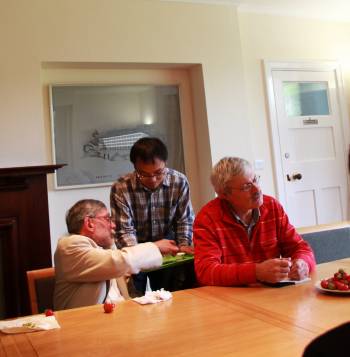
The serving of the tea is also crucial - it is an enjoyment but not drudgery.
- 瓯里蕴香 Wait for a moment,to let the taste and fragrance grow in the Gaiwan.
- 观音出海 Pour the brewed tea through the filter into the Gong Dao Bei.
- 点水留香 Drain off the last few drops of tea equally into the cups.
- 敬奉佳茗 Serve the tea.
- 观汤色,喜闻幽香,品掇甘露 Observe the colour, smell the fragrance, then take a few sips of the tea.
How many times of infusions of tea we could make? There is a verse about it:
七泡余香溪月露,满心喜乐岭云涛。
There are fragrance left after seven times of infusion, like the springs and dews under the moonlight. The heart is filled with joy and happiness, like the varying clouds on top of the mountains.
Experience and understanding of Yiru
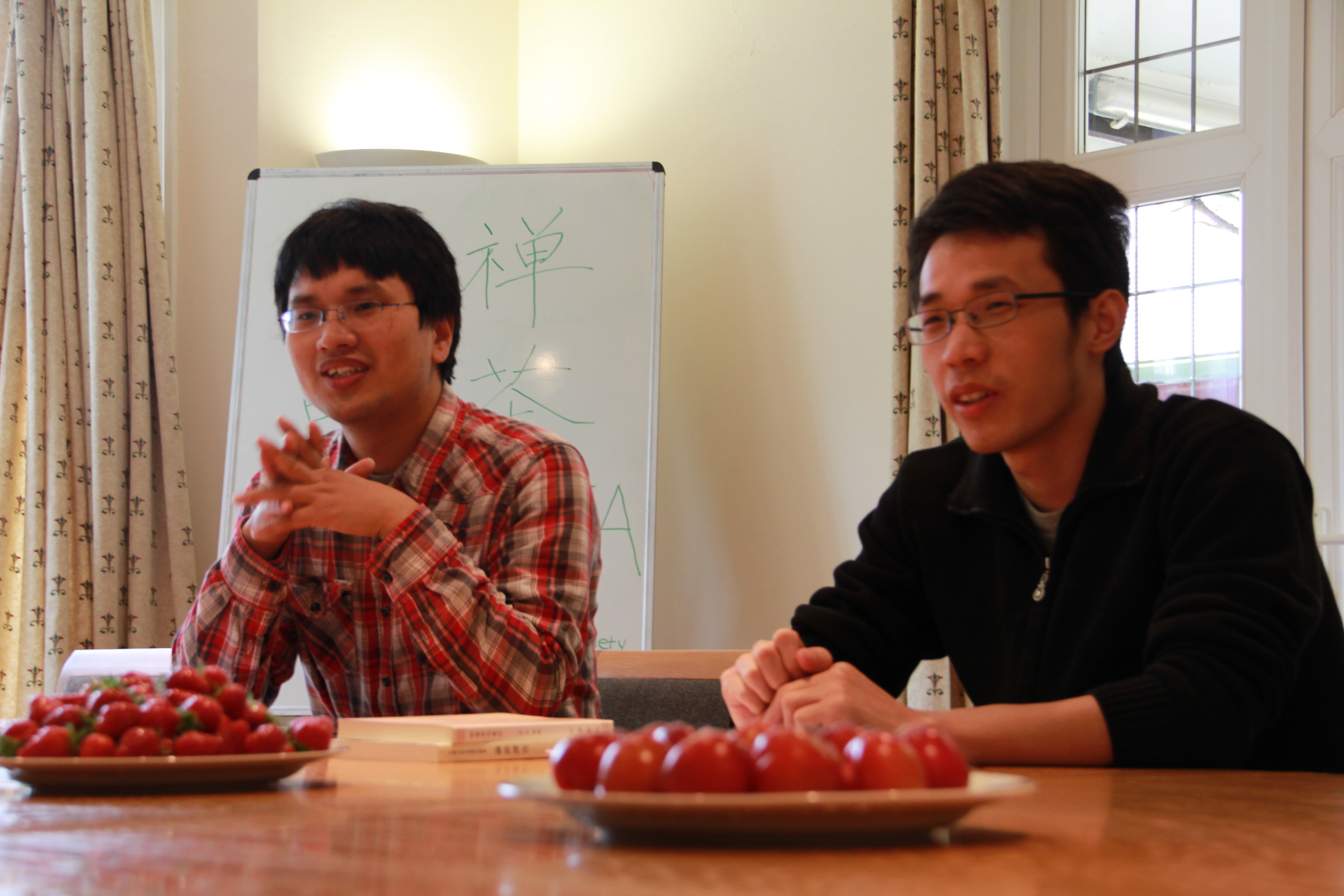
Friends of Cambridge Chinese Classics
Just like doing everything else, from making tea and sharing it with friends, I know a lot. For me, tea and ceremony reveals the way of tea — Chadao, as the living path. Embarking on this path requires only sincerity and a willingness to understand that tea, in all its beautiful forms and our appreciations, can be a life long journey.
Chadao is intimately connected with Zen, and Zen in turn is part of living culture. It cannot be separated from the world, and its spirituality is an integral part of the daily life. It embodied the essential spirit of Chinese Classics culture, Confucian, Taoism, Buddhism in a beautiful and graceful form.
For me, Chadao is a serious thing. It is not just a formal method of drinking tea. It is a practice, with spirituality in the details.
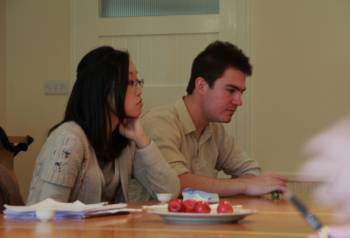
Discuss happily...:)
First, it requires sincerity. In order to have the true taste of the tea and serve it for my friends, I will prepare well with both the physical state of the room, my body, and the mental state in my heart. The tea room, the tea bowl, the quality of the water, and the action of the server are crucial. It may take many years to practice the full way of tea, but this means it is a long path with many stages that will hold our attention.
Such sincerity, faithfulness and dedication we call it Cheng诚 in Chinese. In Chinese Classics The Doctrine of mean, Cheng is emphasized a lot: 为天下至诚,为能尽其性. Only with the most complete sincerity we could fully actualize the essence of ourselves and the other things. During the tea ceremony, we need such sincerity.
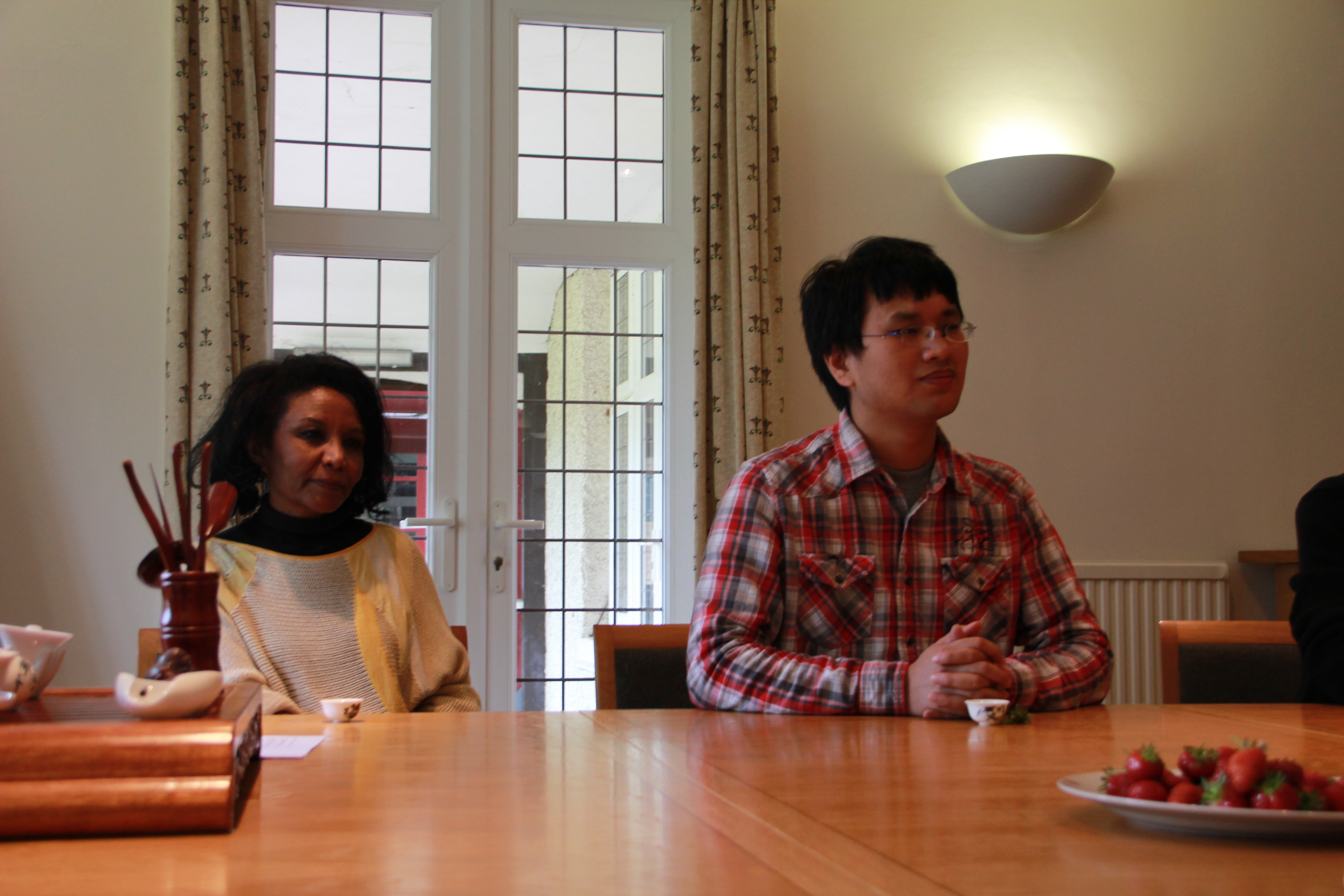
Discuss seriously...:)
One shouldn’t be in a hurry, shouldn’t be bothered with other things, shouldn’t be in an unclear environment, and everything around should be in the right order, put properly, and the air clean and fresh. Ideally, the tea hut is in a garden, close to the dewy breath of the morning leaves, the arrangement of the tea room is in harmony with the soundings and people inside. A proper tea ceremony emphasizes harmony —和. Also in the Doctrine of Mean中庸, it says that: 致中和,天地位焉,万物育焉。Let the states of equilibrium and harmony exist in perfection, and a happy order will prevail throughout heaven and earth, and all things will be nourished and flourish.
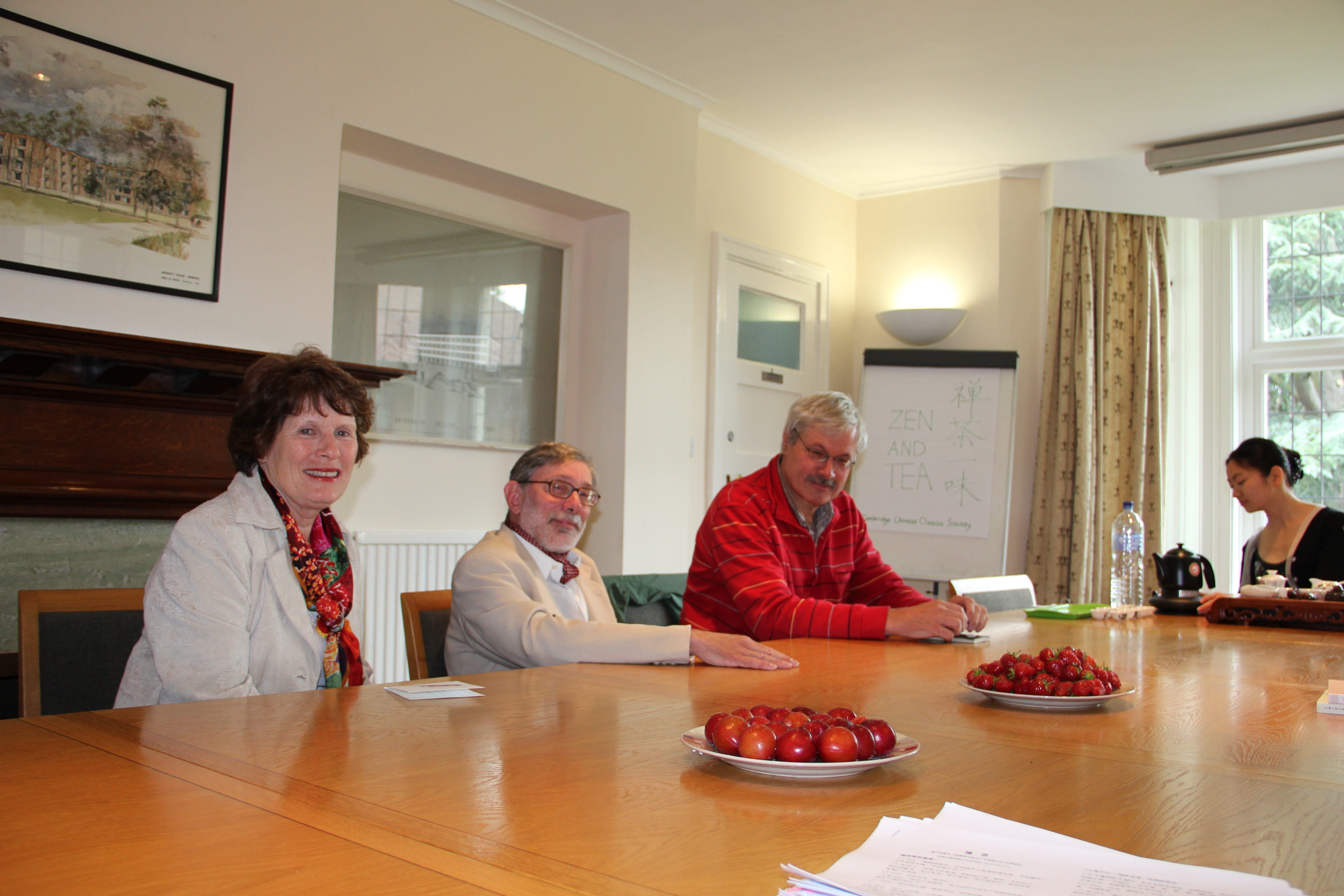
The foreign friends that attended the tea ceremony
To start a tea ceremony with concentration and determination, such focus is the beginning of the spiritual essence of what may seem to be an ordinary job. During process of making the tea, put away all the other things that bother you, and keep a calm, clear and tranquil heart/mind(心境). While concentrating in making the tea, you are also fully aware of all the factors in the environment that will influence and have a good control of it. During this time, your heart is like a brightest mirror, just like the peaceful and clear surface of the water, it reflect things when it calm down, become peaceful, bright, and clear. Such state, in Chinese, we call it Jing (静). One could discover the method and meaning of the task when he is in the state of Jing静. In Chinese Classics Laozi, Jing静 is emphasized a lot: 夫物芸芸,各复归其根,归根曰静,静曰复命,复命曰常,知常明,不知常,妄作,凶。When things in the world have displayed their luxuriant growth, we see each of the return to its root. This returning to their root is what we call the state of stillness; and that stillness may be called a reporting that they have fulfilled their appointed end. The report of that fulfilment is the regular, unchanging rule. To know that unchanging rule is to be intelligent; not to know it leads to wild movements and evil issues.
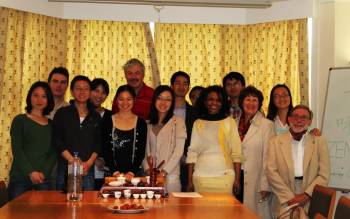
The picture of all together
Breath is at the center of our experience. We cannot live without air, we can do nothing without breath. The master of breath —qi in Chinese — tell us that all life is energy, and all energy is of the breath. It so happens that Chadao is also a way of the breath. The exhale of the host as she enters the room, the steam rising from the kettle, the air whisked into the tea, the fragrance from the surface, and the breath of those who drink from the bowl – all these are ways that our individual breathing falls into harmony with others, with the gardens, and with the greater world on the breezes that flow over the garden walls. Our breath is shaped in very much the same way that the exercises of the meditation masters shape our inhalations and exhalations.
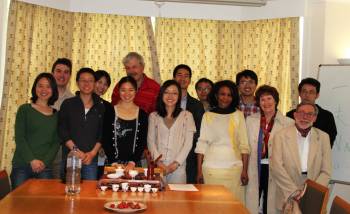
The picture of all together
Therefore, in Laozi, it says, 营魄抱一, 能无离乎;涤除玄鉴,能无疵乎,专气致柔,能婴儿呼?Which emphasize the state of no separation between your body and heart, the clearness of the mind, and the soft and vital concentration of the breath. I think it is just the way that Chadao should be done.
Once you are doing the Chadao in the right way, once you concentrate, you can have a different quality than the work of someone who doesn’t care about what they do. I found there are two different states of doing things. First, you are separated from the work you are doing and all that surrounds them, and you just feel yourself is bounded there, your life is wasted there and you just wanted to ‘get it over’; Second, with sincerity, your whole person, the body, minds and hearts are here, your whole person is connected with the thing you are doing. Then both you and the things are actualized in the fullest essence. You and ‘the tea’ get fully connected, combined in one, and you enjoy the whole! During this process, you forget yourselves, in the meantime you find and enjoy your true self! This is called ‘No self’ 无我 in Buddhism.
So daily task may have spiritual potential, but you must discover the meaning and method of doing it. Concentration and determination is the beginning of the spiritual essence of what may seem to be an ordinary job.
Traditional Chinese tea sets:
- 茶匙 Tea spoon. Useful for moving the right amount of dry tea leaves into the steeping vessel, like Gaiwan or a tea pot.
- 茶夹 Tea Clip. For handling the small tasting cups.
- 茶荷 Tea leaves dish or tea holder. When the correct portion of tea leaves is set aside they are placed in this dish for showing the leaves to all the guests prior to the steeping taking place.
- 盖碗 Gaiwan. It symbollises the harmony between the heaven, the man and the earth.
- 公道杯 又称茶海 Gong Dao Bei (pitcher). This vessel's primary use is for decanting the tea from original Yixing pot or Gaiwan to even the tea soup. It is from this pitcher that the individual cups are poured.
- 茶漏 Tea filter. Used in conjunction with the Gong Dao Bei to pour the ready-to-drink tea out of the Gaiwan, filtering out small particles or tea leaves.
- 品茗杯 Tea bowls for tasting tea.
(Some of the English translations come from http://www.yishanteashop.com/Culture/Gongfu-Tea-Tools.php)
Last edited by Xiaoke Yang, 31-12-2012 11:25:23
Page Tools
User Tools
<html>
© Cambridge Chinese Classics, 2012 - 2017
<script type="text/javascript">
var _gaq = _gaq || [];
_gaq.push(['_setAccount', 'UA-27605058-1']);
_gaq.push(['_trackPageview']);
(function() {
var ga = document.createElement('script'); ga.type = 'text/javascript'; ga.async = true;
ga.src = ('https:' == document.location.protocol ? 'https://ssl' : 'http://www') + '.google-analytics.com/ga.js';
var s = document.getElementsByTagName('script')[0]; s.parentNode.insertBefore(ga, s);
})();
</script>
</html>
